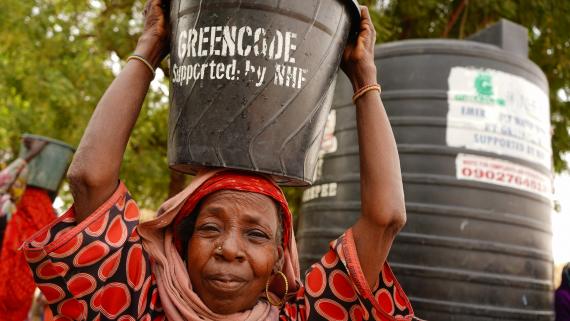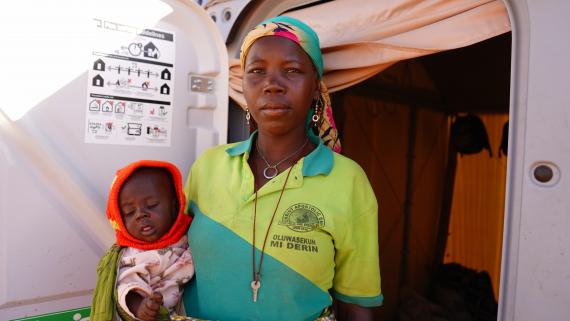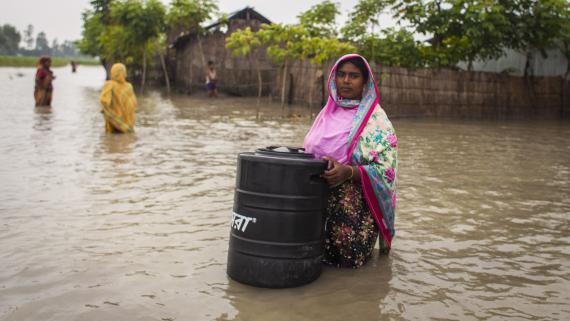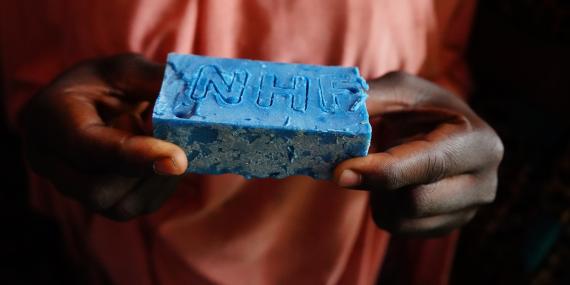Maiduguri, Nigeria
With funding from the Nigeria Humanitarian Fund, local civil-society organization Jireh Doo Foundation is providing capacity-building in soap making to internally displaced women and girls. OCHA/Eve Sabbagh
The Central Emergency Response Fund (CERF) and the Country-based Pooled Funds (CBPFs) continue to serve as critical funding instruments that provide rapid and flexible funding where it is needed most. They enable timely, effective and principled humanitarian action while strengthening leadership, coordination and coherence in emergency responses.
As of 30 October, CERF has allocated more than $676 million directly to 43 countries. This is the highest amount in CERF’s history. The CBPFs have allocated $607 million in 18 country contexts (see table below). Twelve UN agencies and (via IOM) 24 international and national NGOs have received CERF funding, targeting 65 million people. This includes people targeted indirectly with COVID-19 messages, hence the high number.
Pooled Funds allocations per country
CBPFs have allocated funding to 14 UN agencies, 148 international NGOs, 161 national partners and 4 Red Cross/Red Crescent national societies, targeting 88 million people. The ERC assigned the largest-ever amount through CERF’s Underfunded Emergencies (UFE) Window: $225 million was allocated to support crisis response in 20 countries, up from $200 million in 2019, which was itself a record.
CERF and the CBPFs have been at the forefront of the global humanitarian response to the pandemic, supporting local and early action. COVID-19-related allocations account for 28 per cent of all allocations from both funds this year. Through 2020, CBPFs allocated a record 39 per cent of all allocations ($236 million) to local and national humanitarian partners (national NGOs and Red Cross/Red Crescent national societies). This is the largest share of funding.
Top contributions to Pooled Funds
In 2021, COVID-19 and pressures on resource availability will further highlight the CBPFs and CERF’s speed and agility in allocation and disbursement modalities, coupled with stability and economy in administration. Frontline responders will continue to be supported to meet shifting needs on the ground with timely resources, efficient oversight arrangements and flexibility to adapt programmes.
Response to COVID-19
In 2020 CERF and CBPFs placed a major focus on ensuring timely response to COVID-19, while maintaining high-level support to other emergencies. Together, CERF and CBPFs allocated $359 million (28 per cent of all allocations) in 49 country contexts to support humanitarian partners in their pandemic response. This included new allocations and reprogramming of existing grants. CERF and CBPFs have played a critical role in delivering urgently needed frontline humanitarian assistance. Around $168 million has been allocated to international and national NGOs, Red Cross/Red Crescent national societies and other local partners, directly and as sub-grantees of other funds’ recipients. This enabled humanitarian actors to deliver a fast and localized response in key sectors including health, WASH, logistics and protection, including GBV. Among others, 7.9 million units of personal protective equipment (PPE), primary health-care kits and medical supplies have been delivered. The CBPFs and CERF also supported essential protection services for 550,000 people, including psychosocial support, legal counselling and protection-awareness campaigns.
CERF and CBPFs increased their flexibility and agility, making a special effort to support NGOs. CBPFs allocated $223 million for COVID-19 response, with 65 per cent going to NGO partners, including 122 international NGOs, 115 national NGOs and 4 Red Cross/Red Crescent national societies to assist over 41 million people. To date, CERF has allocated more than $215 million to address the primary and secondary humanitarian impacts of COVID-19 in 48 countries.

Golongolong, Nigeria
With a grant from the Nigeria Humanitarian Fund (NHF), the local civil society organization Greencode delivers water to IDPs who are living in an informal settlement about an hour outside Maiduguri. Before the NHF-funded project started, this community had no access to water.
OCHA/Eve SabbaghCERF piloted five innovations during the pandemic:
1. Global UN block grants. In February 2020, CERF made the first-ever global block-grant allocations of $95 million. Providing resources directly to UN agencies at the global level rather than through traditional country-specific grants maximized flexibility to prioritize critical country programmes aligned with the GHRP. Resources were allocated to nine UN agencies between February and May 2020. The funding supported life-saving efforts across 36 countries.
2. Funding for NGOs to support frontline responders. In June 2020, CERF made its first-ever NGO allocation. It channelled $25 million via IOM to 24 frontline NGOs for COVID-19 response in six countries, piloting an approach to provide NGOs with more direct access to CERF funding. One third of the recipients were national NGOs. The projects focused on the WASH and health sectors, including mental health, sexual and reproductive health, GBV response and protection.
3. Funding to support GBV programming. For the first time, CERF earmarked a portion of resources from its UFE window for GBV response activities. The initial provision of $5.5 million from the overall envelope of $100 million had a catalytic effect: across the 10 countries, almost $22 million had been allocated to dedicated GBV projects and health projects that contribute to GBV prevention and mitigation.
4. Support to cash programming in response to rising food insecurity. In November 2020, the ERC allocated $80 million for cash programmes in six countries with severe levels of food insecurity exacerbated by the pandemic. Cash programming is one of the most cost-effective modalities to address humanitarian needs.
5. Flexibility in adjusting CERF projects. Since the pandemic began, CERF has offered a streamlined process to request project extensions and reprogramme funds, if needed, to respond to uncertain operating environments. As of late October, CERF had approved $15.6 million in reprogramming requests for COVID-19-related activities in 30 countries.
"As we fight the spread of COVID-19 in countries already facing humanitarian crises, the work of frontline responders is more important than ever. Because of them, people who desperately need clean drinking water, health care and sanitation – the basics you need to fight the virus – are getting them, wherever they are."
Mark Lowcock, 2020
Funding local action
CBPFs encourage greater participation of national and local humanitarian organizations in decision-making and frontline response. This includes measures to promote access to direct funding as well as through sub-granting programmes, partnerships and consortiums.
In 2020 CBPFs allocated $236 million to local and national NGOs (39 per cent of total CBPFs funding), continuing to be the largest source of direct funding for such organizations. This marked an increase of $4 million compared with the previous year, when local and national NGOs received 34 per cent of total CBPFs funding. Of particular note in 2020 was the Syria Cross-Border Humanitarian Fund, which provided $120 million to local and national NGOs and the Turkish Red Crescent, accounting for 73 per cent of their $165 million allocation that year.
Allocations per type of recipient organization
Supporting the most vulnerable and underserved people
For the second consecutive year, OCHA’s CBPFs and CERF have made significant headway in helping the humanitarian community reach the most vulnerable people. Support for programmes in critically underfunded areas has been encouraged. These include education in protracted crises, and promoting the involvement of affected groups in humanitarian response and protection, including women, girls and people with disabilities.
In 2020, gender equality and support to GBV continued to be an important focus area for CBPFs. The pooled funds allocated $390 million - around 65 per cent of total allocations - to projects that intend to contribute to gender equality with consideration to age groups. This is in line with the IASC Gender with Age Marker (GAM) assessment.
Of the 88 million people targeted by CBPFs partners, 47 million are women and girls (53 per cent). CBPFs have allocated $10.4 million to projects that include GBV programming. Examples include the creation of safe houses for GBV survivors in Wau, South Sudan, by local NGO Nile Hope, and shelter and emergency assistance to GBV survivors in Syria through the NGO Caritas Liban. CBPFs actively promote the participation of women in governance arrangements; across the 18 funds, women represent international NGOs in 13 advisory boards and national NGOs in 12 advisory boards.
Pooled Funds allocations by Gender and Age Marker (GAM)
Gender continued to be a priority for CERF in 2020. All submissions were informed by a gender analysis, with data disaggregated by sex and age, and they had completed the mandatory GAM. Of the 65 million people targeted with life-saving assistance through CERF in 2020, approximately 50 per cent were women and girls.
Quarantine requirements and economic hardship due to the pandemic have led to an increase in GBV. Therefore, CERF increased its support to GBV programming in 2020, allocating an estimated $60 million to GBV-focused projects in by 25 November, up from $30.2 million in all of 2019. For the first time, CERF earmarked a portion of its UFE envelope for GBV programming.

Maradi, Niger
About 40,000 Nigerian refugees have fled the violence in the north-western Nigeria states of Zamfara, Sokoto and Katsina. They were first hosted in a site closer to the border but were relocated as violence began spreading further over the past few months. The new refugee site in Garin Kaka was set up thanks to CERF funding from CERF, which enabled them to set up shelters and children-friendly spaces, and provide food and water, health services and protection assistance. Host communities in the neighbouring village also received some assistance as the large number of refugees relocated to their area could put pressure on the meager resources.
OCHA/Eve SabbaghIn emergencies, people with disabilities are often among the most vulnerable. They are less visible during the assessment phase, partly owing to an overall shortage of reliable baseline data and a lack of technical capacity about how to adapt projects, and they may be unable to access goods and services offered by relief organizations (also see section 1 – 'In focus: persons with disabilities’). In 2019, CERF and CBPFs started systematically tracking activities targeting people with disabilities. In 2020, CERF projects targeted 2.6 million people with disabilities, while CBPFs partners supported 5 million people with disabilities (around 6 per cent of all people targeted) with $5.4 million for focused activities.
Education is often neglected in protracted emergencies, with children missing multiple years of schooling that are difficult to make up (also see Education in emergencies highlight box). In 2020, CERF allocated $26.4 million to emergency education projects, benefiting an estimated 7.4 million children, compared to $15 million in 2018 and $19 million in 2019. Through CBPFs, the education sector received $20 million in 2020 (over 3 per cent of all allocations), targeting around 660,000 children.
The protection sector received $61 million from CERF, which is the highest ever amount in a year and nearly 10 per cent of overall CERF funding. Consequently, the number of people targeted with CERF-funded life-saving protection assistance reached 8.6 million in 2020. CBPFs allocated $60 million to protection activities (10 per cent of total allocations), targeting nearly 4 million people in need. In particular, CBPFs provided $41 million to support child protection activities in different emergencies.
Anticipatory Action
OCHA and partners developed two anticipatory action frameworks in 2020, covering flooding in Bangladesh and drought in Ethiopia, and started work on additional pilots in Chad and Malawi. These follow the development of the first pilot anticipatory action framework in Somalia in 2019. In June 2020, the Somalia framework was triggered for the first time, with CERF providing $15 million to six UN agencies for anticipatory action in five sectors. This action supported 1.3 million Somalis ahead of rising food insecurity and the compounding effects of locusts, floods and COVID-19. Pre-agreed financing and actions made the allocation, review and revision process three times faster than previous slow-onset emergency allocations.

Haldia, Bangladesh
Before flooding peaked in Bangladesh in 2020, FAO provided families with storage drums to protect their valuables such as seeds and tools.
FAO/Fahad KaizerIn 2020, Bangladesh became the first country to use CERF for anticipatory action in a sudden-onset emergency. OCHA and partners successfully scaled up an anticipatory action mechanism set up by the Bangladesh Government, the Red Cross and WFP. In July, $5.2 million in CERF funding was released within four hours of the trigger, indicating a high probability of a severe flooding forecast along the Jamuna River and the need to help 220,000 people protect themselves. This was the fastest release of CERF funding in history.
The Ethiopia framework was set up in November and is ready for activation when forecast thresholds for drought and severe food insecurity are reached.
These three pilot activations demonstrate how anticipatory action can be brought to scale collectively through strong partnerships among implementing organizations, the leadership of UN RCs and HCs and collaboration with national Governments.
Further reading
Source: OCHA
Source: OCHA
References
- All figures in this section reflect data as of 30 October 2020, unless otherwise noted. Slight discrepancies may occur between tables and text due to rounding. For the most up-to-date figures, see CBPF Business Intelligence Portal and CERF Allocation Data.
- An additional 12 countries were reached through agency block grants in CERF’s COVID response.
- Number of people targeted may include double counting as same people may receive assistance from more than one project. This number is therefore not comparable to the CERF figure.
- At the time of writing, a number of projects under the second UFE round of 2020 remained under review but were expected to be approved.
- Number of people targeted may include double counting as same people may receive assistance from more than one project. This number is therefore not comparable to the CERF figure.
- An exception to this was the WFP allocation, which focused exclusively on securing the continuity of supply chains for essential commodities. Also, the initial grant to WHO and UNICEF ($15 million) did not specify GHRP counties, as the allocation was made prior to the GHRP launch.
- Afghanistan ($15 million), Burkina Faso ($6 million), DRC ($7 million), Nigeria ($15 million), South Sudan ($7 million) and Yemen ($30 million).
- Includes grants received as direct recipients ($180.6M) as well as sub-grants received as sub-implementing partners ($55.8M).
- Number of people targeted may include double counting as same people may receive assistance from more than one project.
- OCHA, Evaluation of Country-Based Pooled Funds – Global Synthesis Report, November 2019.
- Number of people targeted may include double counting as same people may receive assistance from more than one project. This number is therefore not comparable to the CERF figure.
- Food security, Health, Nutrition, Protection and WASH.





